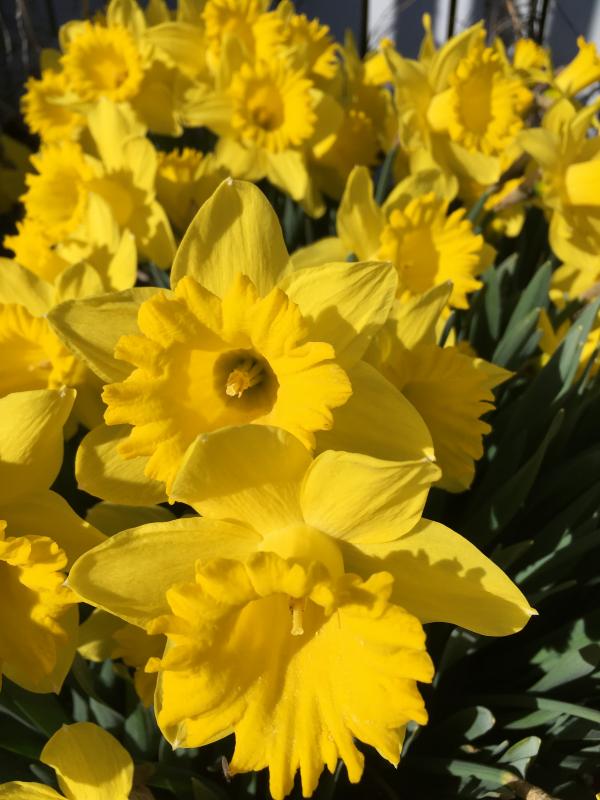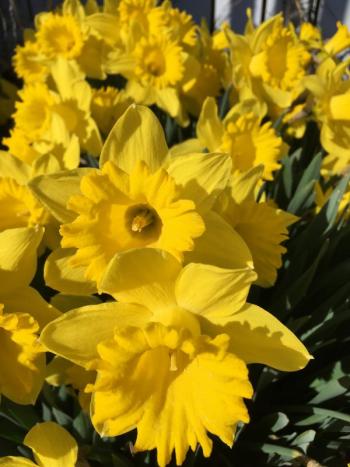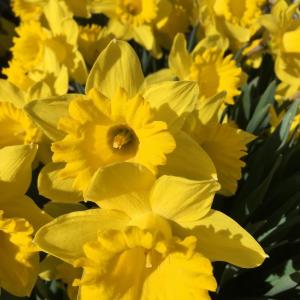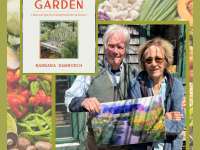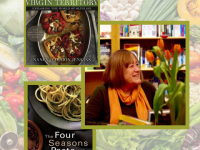This Week in Lincolnville: Waking up the Flower Beds
The first morning spent scrabbling around in my flower beds is a reunion of sorts as one, then another old perennial pokes its first shoots through the litter of leaves and dead stalks. The lavender looks dead, but a little scratch on a twig reveals green underneath, a sure sign it’s alive. The peonies send up distinctive red shoots, the foxgloves green, baby leaves in the middle of the tattered mess left-over from last summer, and everywhere the bulbs are emerging – tulips and daffodils, crocus and scilla. So many came from old friends, long-gone women who gardened here in town.
My husband’s resting place, a long, narrow brick-lined bed in the middle of the vegetables is planted with the contributions of more recent friends: Arlene’s costmary (AKA Bible leaf), Emilia’s yarrow, Amy’s black hollyhock, Richard’s rose. I worried about that rose, a climbing variety he propagated, but which was denuded last summer by some early pest. It leafed out again later, though surely weakened. But it has buds this spring – it obviously survived. This year I’ll sprinkle some rose dust on its new leaves and see if I can baby it along.
Queen of the Prairie is already up at one end of his bed, the plant Wally dug for me on the roadside of the farm where Helen Higgins Butler lived. Letters she wrote and received, 169 of them in the 1870s, were found in the house that stood empty until some 25 years ago when it was burned down. I feel as though I know her from those letters; perhaps she planted the Queen of the Prairie Wally brought home to me.
It’s the old friends – Myra’s forsythia, Hoppi’s speedwell, Barb’s snowdrops, Judith’s poppies, Elizabeth’s cowslips, Phillip’s daylilies, Alda’s white rugosa, my dad’s Washington St. rose – that I hover over every spring. Their faces, even their voices, are evoked by the plants they gave me. Most likely Myra gave me the phlox that’s run rampant through my gardens wherever it’s gained a foothold. At her house, a very old house built near Coleman Pond, the phlox bed was also a certain turtle’s nesting spot. On a certain day every spring (Myra kept a journal of such things) the turtle would struggle up the hill from the swampy edge of the pond to lay her eggs among Myra’s phlox.
I wonder if she still does.
What many of us who share plants with one another might not realize, and I was one, is the way invasive species can sneak in. My weedy nemesis, goutweed (AKA ground elder or bishopsweed) did not exist on this property when we came. Today it’s everywhere. And everywhere in the neighborhood. Perhaps it came tucked away in the rootball of a neighbor’ gift of a plant. If not as a stowaway in a daylily or clump of foxglove it could be the descendants of a plant Hoppi gave me, a pretty white and green leafed thing that made a nice groundcover she said. Within a couple of years that variegated version had reverted back to its more vigorous variety, solid green, and began spreading everywhere.
CALENDAR
WEDNESDAY, Apr. 21
Library book pick-up, 3-6 p.m.
SATURDAY, April 21
Library book pickup, 9 a.m.-noon, Library
EVERY WEEK
AA meetings, Tuesdays & Fridays at noon, Norton Pond/Breezemere Bandstand
Lincolnville Community Library, curbside pickup Wednesdays, 3-6 p.m. and Saturdays, 9 a.m.-noon. For information call 706-3896.
Soup Café, cancelled through the pandemic
Schoolhouse Museum open by appointment, 505-5101 or 789-5987
Bayshore Baptist Church, Sunday School for all ages, 9:30 a.m., Worship Service at 11 a.m., Atlantic Highway, In person and on Facebook
United Christian Church, Worship Service 9:30 a.m. via Zoom
COMING SOON
May 2: LHS BBQ Pick-up/Take-out Meal
You can’t dig it up as it sends runners everywhere underground, two to eighteen inches deep, under rocks, amongst tree and shrub roots, tangled in your peony tubers and strangling any other perennials it encounters.
Rumor has it that gardeners have sold their houses and moved to get away from it. I’ve chosen to live with it. Every spring as it begins its annual migration through the garden I gird myself for battle and tackle the Front, the line beyond which I won’t let it go. Looking at my house from the road, the garden in front of the sun room, full of tulips in the spring, is goutweed-free. The bed to the left belongs to Him, Mr. Goutweed. I’ll never get him out of there.
This year on the first day you see people out raking their yards, I sat indoors, nursing my bad knee. The soft air and bright light drew me to the window, but there was no way I’d be digging in the dirt anytime soon. Since I’ve been doing that since I was a toddler following my dad around his garden, it was a blow. Actually, to be honest, there’s the exception of those fraught teen years when a kid often loses touch with who they are, or at least I did. It took high school, college and a year living and working in the city to bring me back to my senses, to what I loved.
And that was a piece of dirt where I could grow things. A garden.
By the time the next warmish day had arrived a week or two ago, I’d figured out how to get down on the ground and scooch around to clean up the beds. The metal plant stakes had come apart, their little nameplates faded and scattered around the rock garden. We’d put them all over last year, marking the herbs and perennials so the grandchildren could learn the names of the plants. Jack’s favorite is sorrel and he doesn’t need a nameplate for it. He’s out there first thing each spring, nibbling its sour, lemony-flavored leaves.
It was satisfying to sit in the warm sun, finger-raking the dead leaves off the dainty plants that sprawl over the rocks and trimming away the dead parts. The faded tags read “dianthus”, “armeria”, “cowslip”, “rue”, “Irish moss”, “Maggie’s iris” … each one evoking a different memory, a feeling, a smell. It’s not unlike knitting or any other handwork where the action is complemented by the emotion of the actor and embedded in the work. Does that make sense?
With a Sharpie pen I re-wrote the names of each plant on the stake and set them in the ground. It turns out that those permanent Sharpies fade in the sun; a special grease pencil is better but I can’t find mine.
I’m remembering another old friend these days as I work in the garden: Joan Carol Baker. Many will remember her living in the Center next door to the old fire station, (How’s that for Maine directions?) The backyard was a wonderful jumble of gardens and sheds and yards for chickens and geese, ducks, pigs, and goats, and for a spell, a pair of peacocks. Their insistent call sounds like something from the jungle, as Ric McKittrick recalled from his days living up the road, quite an incongruity in Lincolnville Center.
The Bakers moved to Hope decades ago where she and Rene continued to raise vegetables and flowers, chickens and pigs. Joan Carol became increasingly disabled over the years, the result of a long-age automobile accident, but she never lost her love of growing plants, both indoors and out. When she was wheel-chair bound her son built tall garden beds on the deck which she could tend from her chair. She shared many plants with me over the years, cuttings and clumps and seeds. I learned as much from her, both plant lore and human lore – how to survive the worst life can throw at you – as from anyone else in my life.
Joan Carol too lives on in this house of ours, in this garden, along with so many others who’ve shared with me.
Town
Have you thought about getting involved in town affairs? Whether you’re a lifelong resident or newly-arrived, there are always openings on town committees. See the list of them here.
Most meet monthly for a couple of hours, and all of them offer a chance to serve the town, meet new people, and learn more about this place where we all live.
Beach Schoolhouse Project
The next pick-up, take-out meal (and last until next fall) will be Andy Young’s Piggyback BBQ meal, Sunday May 2, 1-3 p.m. at 33 Beach Road.
The meal includes a ribs/brisket/pulled pork combo, BBQ baked beans, cole slaw, cornbread, and cookies for $25 each. Like the other meals this winter, you pre-order and pay when you pick up. To order, or to donate a meal, email Chris Leary or call Diane, 789-5987. Each of these pick-up meals have generated several donated meals which are then delivered to the person of your choice, or to someone who may be shut in, having health issues, etc.
Condolences
This past week we learned that Tony Cardner died. Perhaps you never knew him, or his brother Mike, though Tony went to high school in Camden and the brothers lived in Lincolnville from then on. The two were born with CTX, a rare degenerative genetic disease of the brain which attacks the entire body. The brothers were often in Camden when they were younger, where they were well-known by Main Street business people. Tony worked at the Coastal Workshop, Merry Spring Gardens, and Marriner’s Restaurant.
Their mother, Carmela, looked after them in her home on Heal Road where they lived with caretakers the rest of their lives after she died. Mike pre-deceased Tony by several years. Sympathy to their family members.
Event Date
Address
United States

